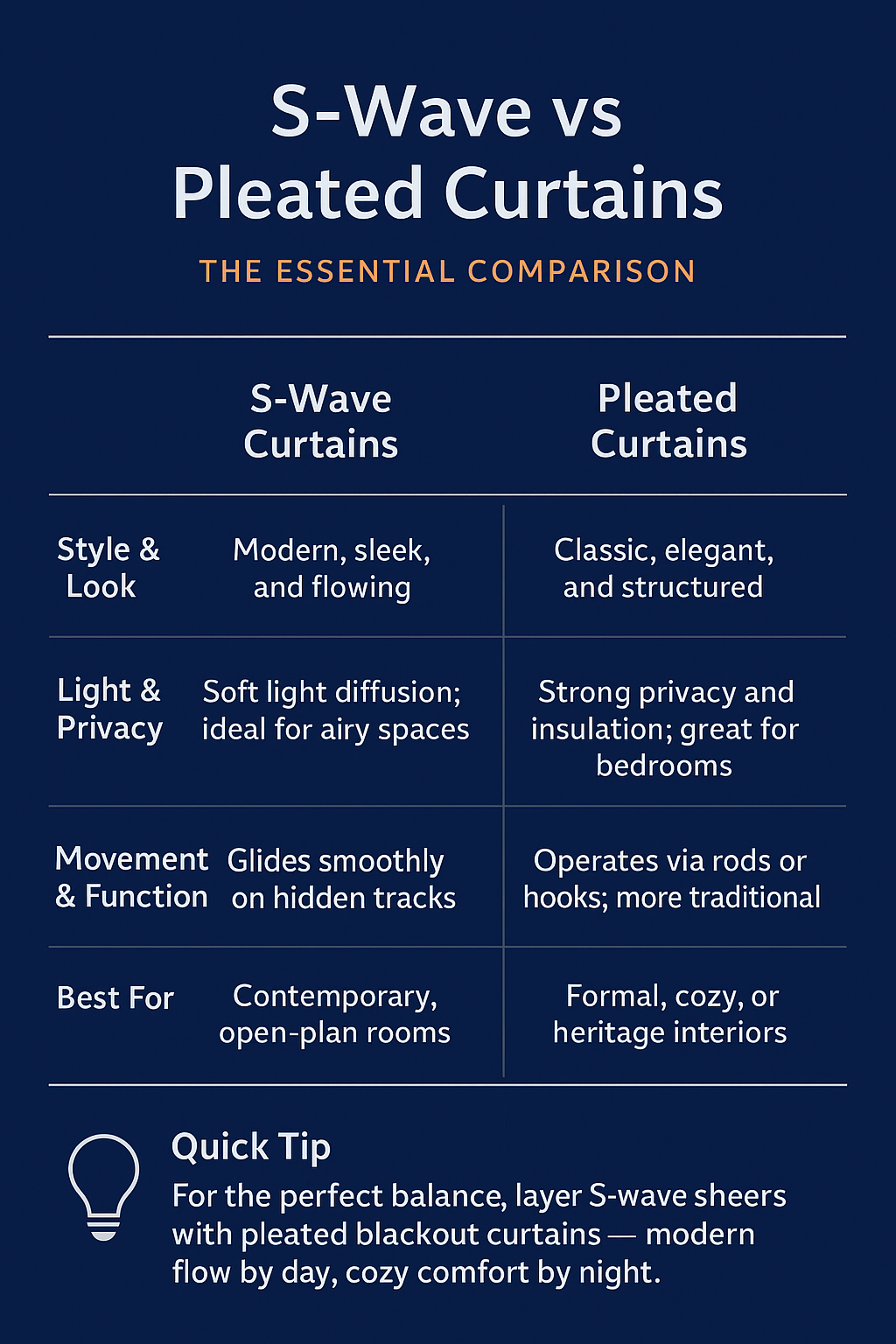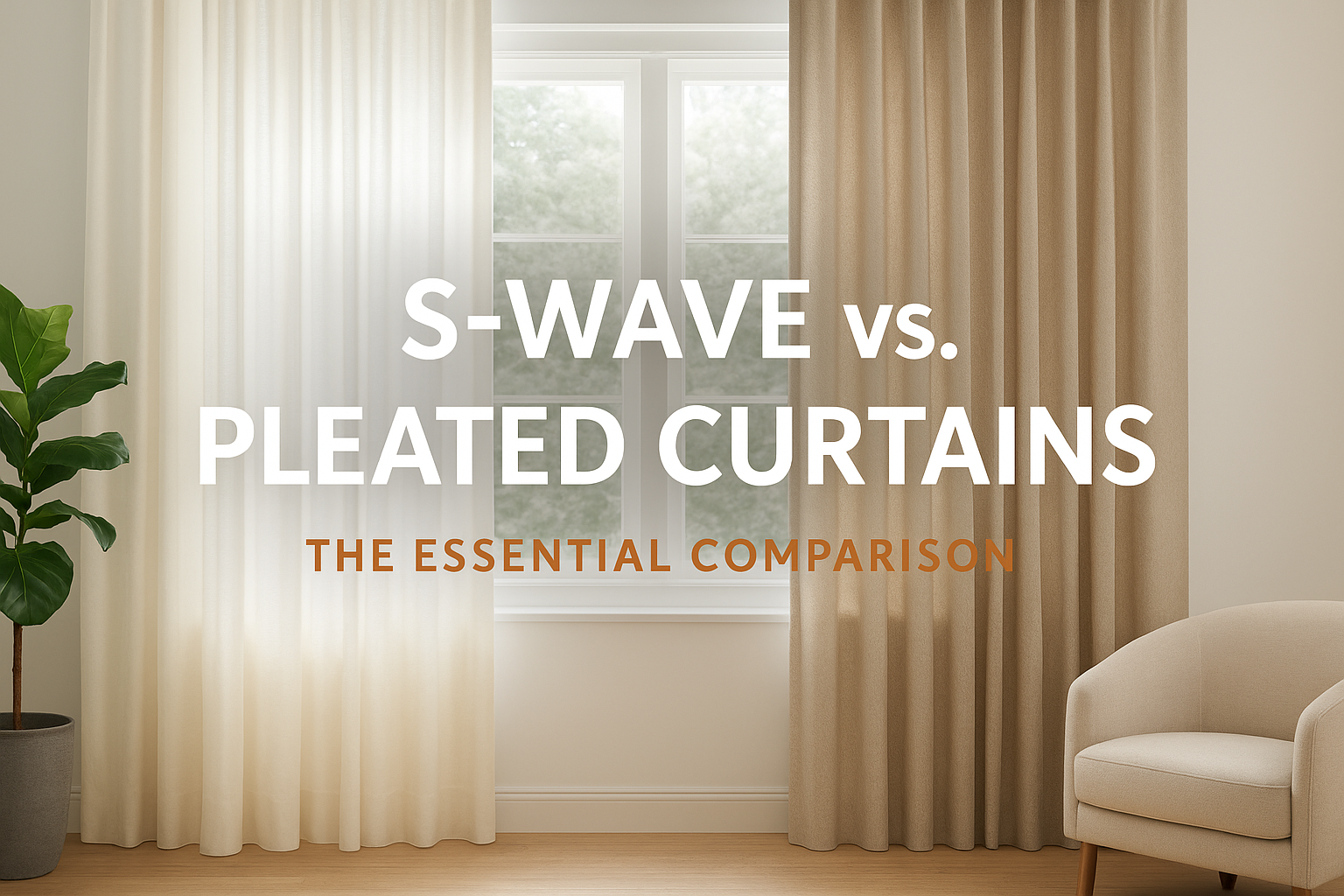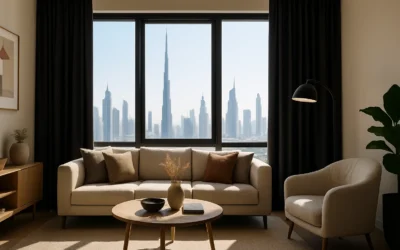Introduction: Why Curtain Style Matters More Than You Think
Curtains do more than just block sunlight—they frame your space, shape its atmosphere, and define how light moves through your home. The choice between S-wave vs pleated curtains is more than a design decision; it’s about balancing function, texture, and flow.
Both styles are elegant, timeless, and versatile—but they differ in structure, drape, and the visual rhythm they create. If you’re unsure which is right for your living room, bedroom, or modern open-plan space, this guide will help you decide with confidence.
What Are S-Wave Curtains?
S-wave curtains (sometimes called ripple fold curtains) feature a smooth, continuous wave that runs evenly across the track. The name comes from the soft “S” shape the fabric forms when hung.
Key features of S-wave curtains:
- Uniform waves: Each fold is evenly spaced, giving the fabric a fluid, modern flow.
- Minimal hardware: The curtain glides along a discreet track, ideal for ceiling-to-floor installations.
- Effortless movement: They open and close smoothly—perfect for large windows or sliding doors.
- Soft aesthetic: The wave design complements minimalist, Scandinavian, and contemporary interiors.
In essence, S-wave curtains bring a modern, architectural calm to a space—ideal for rooms where light and openness are central to the design.
What Are Pleated Curtains?
Pleated curtains are a classic window treatment defined by folds gathered at the top. Unlike the uniform S-wave, pleats are created through structured stitching or hooks, giving the fabric a more tailored, traditional look.
There are several pleat styles, including:
- Pencil pleats: Tight, narrow folds for a versatile and elegant look.
- Pinch pleats: Sewn-in pleats that fan out beautifully—often used in formal living spaces.
- Box pleats: Even, deep folds for a structured, luxurious appearance.
Key benefits of pleated curtains:
- Timeless design: Suits both traditional and transitional interiors.
- Customizable fullness: Adjust the pleat depth for a softer or more formal look.
- Elegant framing: Works well in bedrooms, dining areas, and heritage-style homes.
Pleated curtains add texture and sophistication, making them perfect for creating depth and warmth in spaces with classic or layered design schemes.
Aesthetic Comparison: Modern Flow vs. Classic Structure of S-Wave vs Pleated Curtains
| Feature | S-Wave Curtains | Pleated Curtains |
| Style | Contemporary, clean, minimal | Traditional, formal, timeless |
| Drape | Soft, uniform waves | Structured, gathered folds |
| Best For | Modern apartments, open living spaces | Bedrooms, dining rooms, heritage interiors |
| Hardware | Track-mounted, hidden | Rod-mounted or hook-based |
| Maintenance | Easy to glide and clean | May require more adjustment and upkeep |
| Light Control | Smooth diffusion | Enhanced coverage and privacy |
If your space leans toward open-plan layouts, glass walls, or a neutral palette, S-wave curtains enhance the sense of openness and light. If your home celebrates texture, symmetry, and detail, pleated curtains lend a touch of elegance and depth.
Functionality: Light, Privacy, and Movement
Light & Privacy:
S-wave curtains are great for soft light diffusion—they filter sunlight evenly, reducing glare without darkening the space. Pleated curtains, especially with lined or blackout fabrics, provide superior privacy and insulation, making them ideal for bedrooms or media rooms.
Ease of Use:
Because S-wave curtains glide along a track, they move effortlessly—great for large windows or daily use. Pleated curtains, while smooth, often depend on rods or rings and can require more manual adjustment.
Space Considerations:
S-wave curtains need more width for their even wave pattern, while pleated curtains can be installed in tighter spaces without sacrificing fullness.
Design Impact: How Each Curtain Shapes a Room among S-Wave vs Pleated Curtains

S-Wave Curtains
- Create a seamless, floating effect that makes ceilings appear higher.
- Enhance visual flow in modern, minimalist, or coastal interiors.
- Pair beautifully with sheer fabrics for a soft, ambient glow.
Pleated Curtains
- Work well with heavier drapes, velvet, or jacquard materials for a luxurious finish.
- Add texture and rhythm, perfect for balancing ornate or vintage furniture.
- Offer a layered look when paired with valances or pelmets.
If your goal is a clean, gallery-like aesthetic, go with S-wave. If you’re after a warm, inviting, and timeless space, pleats will always deliver.
Installation and Maintenance
S-Wave:
Installed on discreet tracks, often from ceiling to floor. Ideal for motorized systems or smart-home integration. The track’s minimal visibility enhances architectural precision.
Pleated:
Usually mounted on rods or poles, which can serve as decorative accents. While installation is straightforward, pleats may need occasional reshaping after cleaning to maintain their structure.
Care Tip:
Always check the fabric type—synthetic blends and lighter materials are easier to maintain than heavy or lined drapes. For both styles, regular steaming or gentle vacuuming helps preserve their texture and drape.
Which Curtain Style Is Best for You: S-Wave vs Pleated Curtains?
Choose S-Wave Curtains if you:
- Love a modern, uncluttered aesthetic.
- Have wide or floor-to-ceiling windows.
- Want easy-glide operation or motorized control.
- Prefer a soft, flowing light diffusion effect.
Choose Pleated Curtains if you:
- Appreciate timeless or formal interior design.
- Need better light blocking and insulation.
- Want to create a cozy, layered atmosphere.
- Have traditional windows or classic architectural details.
Expert Design Tip: Combine for Versatility
For the best of both worlds, layer S-wave sheers behind pleated blackout curtains. This hybrid setup lets you adjust light and privacy throughout the day—sheers for daylight ambiance, pleats for nighttime comfort and elegance.
Conclusion: The Right Curtain Defines the Room
When choosing between S-Wave vs Pleated Curtains, think beyond looks—consider how your space feels, functions, and flows. S-wave curtains deliver a modern, effortless elegance; pleated curtains bring depth and refinement.
Your choice should harmonize with your interior style, lifestyle, and the room’s purpose. In the end, both styles can elevate your space—when chosen with intention and designed for both form and function.




